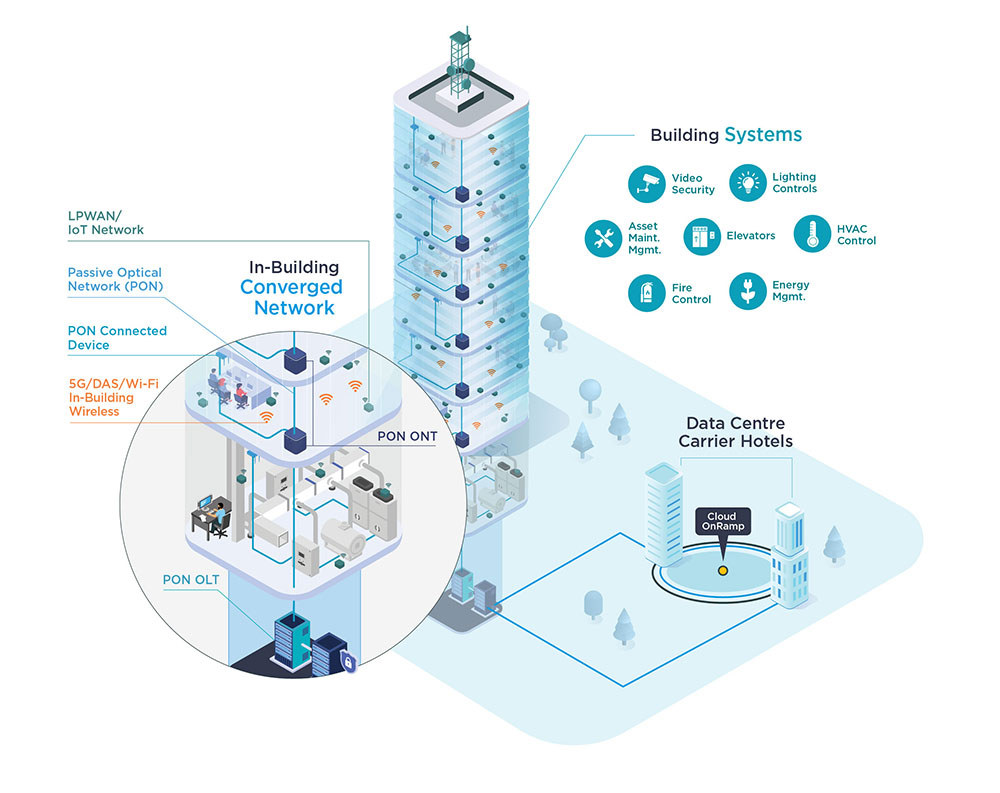In today’s constantly evolving real estate landscape, it is crucial for operators to embrace smart building technologies. With the growing focus on reducing energy consumption, ensuring environmental sustainability, enhancing tenant wellness and comfort, the need to implement advanced technologies has never been greater.
Features such as air quality control, occupancy sensing, smart lighting, and access controls, coupled with comprehensive IoT sensor data collection, are now essential components of a modern building. At the heart of the building modernization lies the concept of a converged network, a powerful and necessary infrastructure that serves as the digital foundation of smart buildings. In this article, we will explore the significance of a converged network for buildings and its undeniable benefits.
Why Buildings Need a Converged Network
To make a building smart, it is essential to gather data from various systems, analyze it, and implement improvements. However, the current setup in most buildings includes separate networks for different systems, such as HVAC, lighting, and elevators, installed by different companies. These isolated networks make it cumbersome and time-consuming to collect all the necessary data, akin to individual puzzle pieces that don’t fit together smoothly. To unlock the full potential of a smart building and achieve optimal performance, all these separate networks must be connected into a unified platform to ensure efficient and proper data collection. This is where a converged network for the building steps in.
The Power of a Converged Network for Smart Buildings
A converged network, also referred to as the Base Building Network (BBN), serves as the backbone of smart and sustainable buildings. It enables all building OT (Operational Technology) systems and devices to connect to an integrated network while ensuring secure access to the data. As technology evolves and new devices are introduced, a well-designed converged network can easily accommodate these changes, eliminating the need for extensive rewiring or costly upgrades.

Once the converged network is established, the building can become truly smart. It allows for a more efficient and timely way to collect data, leading to decisions that help make the building more energy efficient and sustainable. For instance, the building owner can monitor heating costs, optimize system operations, and focus on areas that need improvement (like turning off heating when the building is empty).
The converged network also helps different systems work together. By having all the data flowing through one backbone network, the building operator can easily correlate different information and take appropriate actions.
For example, sensors can adjust blinds based on daylight time or occupancy, saving energy and improving comfort. This allows the building operations to see the bigger picture and optimize the building’s performance.
In summary, converged networks are the foundation of smart and sustainable buildings. They bring together diverse systems, facilitate real-time data collection and analysis, enhance scalability and flexibility, and ensure security. By embracing converged networks, building owners and operators can unlock the full potential of smart building technologies, creating environments that are more energy-efficient, cost-effective, and comfortable for occupants. The adoption of a Converged Networking System has become imperative for modern buildings looking to stay ahead in the ever-changing world of smart technology.
View this Nexus Labs Podcast that explores how the implementation of a PON-based converged network
has made an impact at over 50 Quadreal buildings across North America.
Contact Andorix to Learn More
Andorix offers a managed in-building converged network solution that is purpose-built for Real Estate Operators and Tenants and provides a vendor-agnostic platform for 5G, IoT & future smart building technology readiness. Contact us today to learn more about how we can help you implement a converged network for your building.






